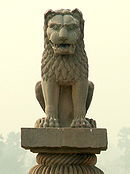- Dhammapala
-
- See also Dharmapala (disambiguation)

Countries
Sri Lanka
Cambodia • Laos
Burma • ThailandHistory
Pre-sectarian Buddhism
Early schools • Sthavira
Asoka • Third Council
Vibhajjavada
Mahinda • Sanghamitta
Dipavamsa • Mahavamsa
BuddhaghosaDoctrine
Saṃsāra • Nibbāna
Middle Way
Noble Eightfold Path
Four Noble Truths
Enlightenment Stages
Precepts • Three Jewels
Outline of BuddhismDhammapala was the name of at least two great Theravada Buddhist commentators. One who lived at the Badara Tittha Vihara, near the east coast of India, just a little south of where Chennai now stands, wrote the commentaries on seven of the shorter canonical books, consisting almost entirely of verses, and also the commentary on the Netti, perhaps the oldest Pali work outside the canon. Extracts from the latter work, and the whole of three out of the seven others, have been published in Pali by the Pali Text Society. These works show great learning, exegetical skill and sound judgment. But as to the meaning of words, or to discussions of the ethical import of his texts, very little can be gathered from his writings of value for the social history of his time. For the right interpretation of the difficult texts on which he comments, they are indispensable.
Though in all probability a Tamil by birth, he declares, in the opening lines of those of his works that have been edited, that he followed the tradition of the Great Minister (Maha Vihara) at Anuradhapura in Sri Lanka, and the works themselves confirm this in every respect.
Another writer, probably also called Dhammapala, since he was supposed by the 12th century to be the same, though scholars do not accept this, wrote subcommentaries on the commentaries on the Digha, Majjhima and Samyutta Nikayas.
A third Dhammapala wrote Saccasankhepa, a handbook of abhidhamma.
Sources
- Edmund Hardy in Zeitschrift der deutschen morgenlandischen Gesdllschaft (1898), pp. 97 foll.
- Netti-ppakaranam: The guide, according to Kaccana Thera (ed. E. Hardy, London, Pali Text Society, 1902, ISBN B0000CLJ95), especially the Introduction, passim
- Theri Gatha Commentary, Peta Vatthu Commentary, and Vimna Vutthu Commentary, all three published by the Pali Text Society.
- K.R. Norman, Pali Literature, Otto Harrassowitz, Wiesbaden, 1983
- Oskar von Hinüber, Handbook of Pali Literature, Walter de Gruyter, Berlin, 1996
References
 This article incorporates text from a publication now in the public domain: Chisholm, Hugh, ed (1911). Encyclopædia Britannica (11th ed.). Cambridge University Press.
This article incorporates text from a publication now in the public domain: Chisholm, Hugh, ed (1911). Encyclopædia Britannica (11th ed.). Cambridge University Press.
Categories:- Buddhist philosophers
- Tamil Buddhism
Wikimedia Foundation. 2010.
